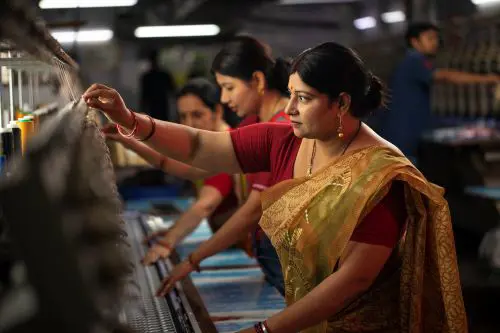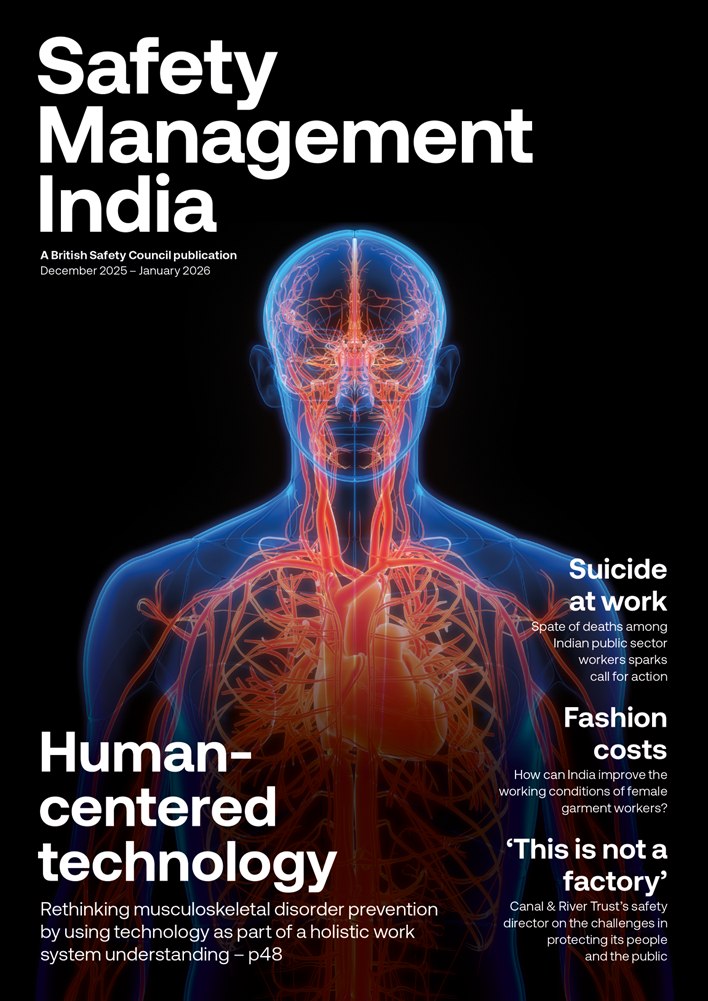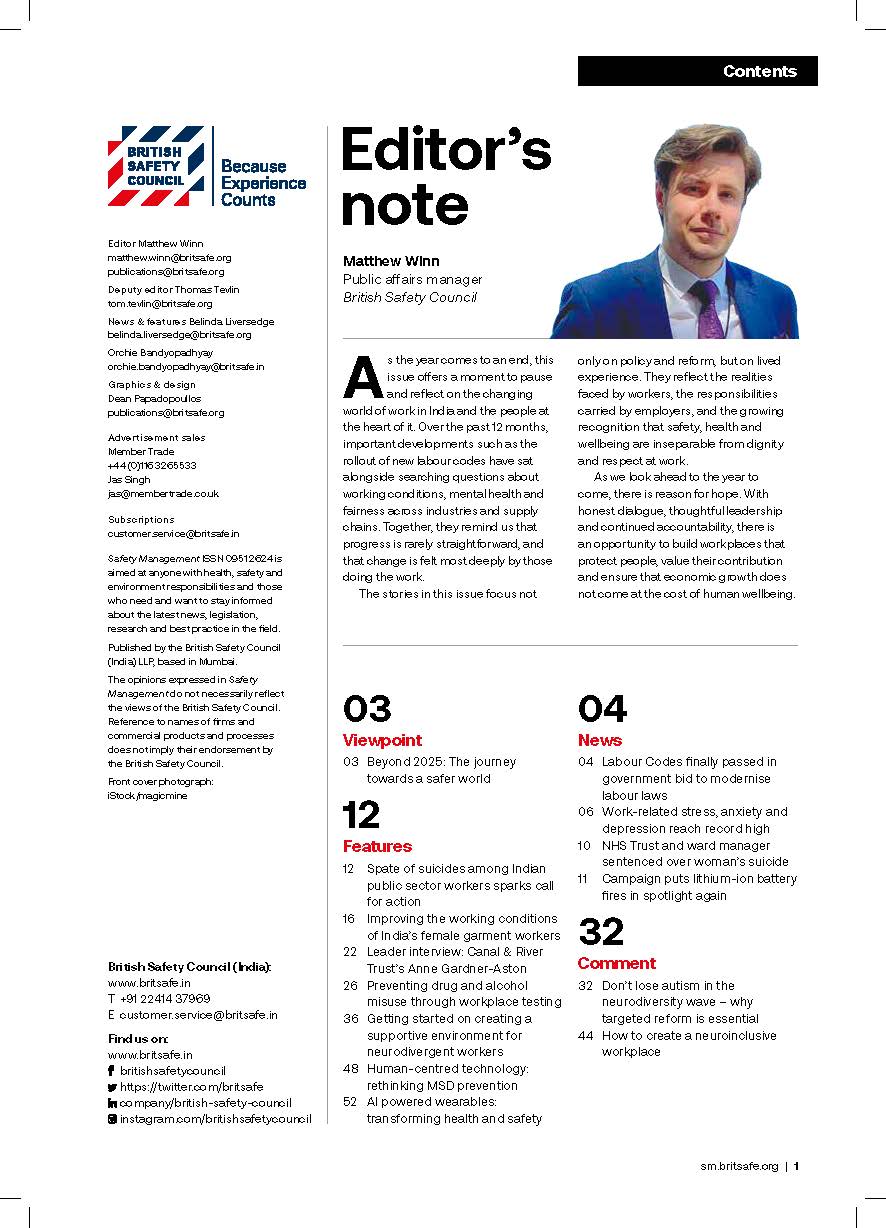With deaths on construction sites a daily occurrence, campaigners say the central and state governments need to increase safety inspections – and ensure construction workers can access the social security benefits they are entitled to.
Features
Construction in India: a dangerous business
Although the construction industry is one of the largest sectors of employment in India, it is also the second most hazardous, with an average of around 38 fatal accidents a day.
According to a 2019 study by the Indian Institute of Technology (IIT) Delhi, falls, electrocutions and collapsing walls and scaffolding at construction sites are the leading causes of work-related deaths in the construction industry. Another study published in 2016 by researchers at the National Institute of Technology Surat and IIT Delhi estimated that the construction industry accounts for around a quarter of all workplace accident fatalities in India.
Suresh Tanwar, head of audit and consultancy at British Safety Council India, said: “The construction industry remains largely unorganised in India.
"The nature of the work being undertaken at construction sites is fraught with risks – such as falling objects, falls from heights, electrocution, heavy material handling by crane and the collapse of structures. The fallout of these types of accidents can be fatal.”
The 2016 study from the National Institute of Technology Surat and IIT Delhi estimated that around 48,000 people are killed in accidents at work in India every year, with construction accounting for at least 11,614 of the fatalities.
However, experts say the death toll among construction workers is likely to be much higher as most fatal accidents on sites – and serious injuries that result in death at a later stage, such as after the worker has been discharged from hospital – are not reported at all.
Construction attracts rural migrants
Although many construction workers face unsafe and unhealthy working and living conditions – such as poor accommodation, food and sanitation, unsafe working practices and inadequate healthcare provision and insurance cover – they are attracted to the work because employment is more reliable and pays better wages than working as an agricultural labourer.
In fact, the construction industry is one of the largest employers of rural workers who migrate to towns and cities in search of work due to factors like a lack of employment opportunities in villages or farming and chronic poverty.
According to government data, the construction industry contributes nine per cent of India’s gross domestic product (GDP) and employs 51 million workers, making it the second largest employment sector after agriculture.
However, many construction workers have poor employment conditions and protections and their workplace is often a dangerous, ill-equipped site.
Reports of fatal and serious construction site accidents appear every day in the media.
On 27 August, a 28-year-old construction worker died after he slipped and fell from a height of about 7.5 metres while removing wooden planks installed to support slabs from a two-storey building undergoing construction in Pune. The police later charged the contractor in charge of the work and the building owner for allegedly causing the worker’s death due to negligence under section 304(A) of the Indian Penal Code (IPC).
According to the police, an inspection of the construction site soon after the incident revealed that those in control of the work had not taken safety measures like installing security nets and had not provide helmets or safety belts to the workers.
In another deadly incident on 14 September, seven labourers were killed and one seriously injured after a structure they were working underneath inside an elevator shaft collapsed on top of them at a building undergoing construction in Ahmedabad.
Several of the workers fell from a wooden platform they were standing on after the structure collapsed, causing them to fall up to seven storeys to the bottom of the lift shaft.
In a statement, local police said that a contractor and two sub-contractors had been arrested for alleged offences under Section 304 of the IPC (culpable homicide not amounting to murder) and Section 114 (the abbetor being present when an offence is committed).
“No safety nets or any other safety measures were used for the labourers working in the elevator passage/duct,” said the police statement, according to media reports. “It is a case of severe negligence as it was known that there is risk to the life of labourers.”
Jayesh Patel, secretary of the Ahmedabad District Organising Committee of the Socialist Unity Centre of India (Communist) Party, or SUCI(C), reportedly later wrote to Gujarat’s chief minister, Bhupendra Patel, demanding strict punishment for those whose negligence led to the fatal incident.
SUCI(C) also demanded the responsible contractor should pay fair compensation to the families of the deceased, provide employment to deserving family members of the deceased and injured worker as an additional form of financial compensation, and meet the medical costs of the seriously injured worker.
In another incident in Noida on 20 September, four construction workers lost their lives and eight were injured after a boundary wall collapsed during the cleaning of a drain. The drain cleaning work was being undertaken by labourers working for a contractor hired by the Noida Authority, it was reported, and the men were buried under the debris.
Following the incident, the chief executive officer of the Noida Authority announced compensation payments of Rs 5 lakh to each family of the deceased.
According to media reports, the contractor had been warned by local people that the boundary wall was weak prior to cleaning the drain.
According to Noida district magistrate Suhas LY, when the labourers were pulling out bricks, the wall collapsed. “It [the incident] will be probed,” said the magistrate.
However, fatal and serious incidents like these continue to happen with alarming frequency as most contractors who hire casual labourers rarely follow basic health and safety rules and procedures. Workers are often not provided with, or use, safety gear like helmets, gloves, jackets, harnesses or nets as is mandatory under the law.
Lack of personal protective equipment
Construction workers regularly report that contractors do not provide them with any personal protective equipment. Krishna Kumar, a construction worker in Noida, said: “The contractor comes once in a week and only wants the work to be completed at breakneck speed. Our safety is his last priority.”
Experts say that much more frequent and rigorous safety inspections of construction sites by the enforcement authorities are required to prevent fatal and serious accidents.
Jeetendra Ghadge, a right to information (RTI) activist, who campaigns for the release of information that may be in the wider public interest from public authorities like local and city governments, said just taking prosecutions against the individuals whose negligence has resulted in construction deaths and injuries is an ineffective way of improving the industry’s poor health and safety record.
“Instead, we should make sure the safety measures are followed strictly so that such incidents never happen,” he said. “We need to have a labour police to make sure the rights of poor labourers are protected.”
 Photograph iStock credit Anil Dave
Photograph iStock credit Anil Dave
Big companies seek to share best practice
Meanwhile, companies like Tata BlueScope Steel – a major manufacturer of pre-fabricated steel products for the construction industry, such as roof frames and pre-engineered buildings – argue that one effective way of improving health and safety in the industry is to ensure workers are given suitable training so they have a much greater awareness and understanding of the potential dangers they face and how to avoid them.
Tata BlueScope Steel recently launched a training programme designed to teach roofers and structural riggers how to work safely at height and handle equipment safely when erecting steel-framed buildings and structures.
The programme, which was developed in associated with the Construction Industry Development Council (CIDC) and NITI Aayog, the Indian government’s public policy think tank, was initially delivered to 50 roofers and riggers from the construction industry at Tata Steel Meramandali (TSM), in the Dhenkanal district of Odisha.
As well as ensuring the riggers know how to work safely, the programme is designed to help address the shortage of professionally trained structural riggers and roofers in the country.
The training module has been accepted and approved by more than 180 government departments, and it is hoped it will be expanded across India.
Meanwhile, Larsen & Toubro (L&T), one of India’s biggest engineering and construction companies, aims to lead by example by becoming a ‘zero harm’ company.
The initiative means that L&T is doing everything possible to prevent accidents and injuries from happening at the sites under its control – for example, by implementing rigorous health and safety procedures and training programmes; constantly monitoring and improving workplace health and safety standards; and harnessing new health and safety technologies.
All L&T work sites are also certified under ISO 45001, the international occupational health and safety management standard. This sets out a internationally-agreed and effective approach for managing risks to the health and safety of workers and others who could be put at risk by work activities, such as members of the public.
L&T has also developed a robust online health and safety training module that teaches construction workers about the health and safety requirements it expects on all of its sites and projects. As the construction workers are drawn from different parts of the country, the interactive online training is available in several Indian languages.
Suresh Tanwar, from the British Safety Council in India, says that a number of the construction companies in India have adopted effective practices and systems for managing health and safety risks. These include dynamic risk assessment, which is the continuous process of identifying hazards, assessing risks, taking action to eliminate or reduce risks and monitoring and reviewing hazards and risks during the rapidly changing circumstances of a project or task.
For the best companies, toolbox talks (regular informal meetings where construction managers and workers are briefed about and discuss hazards, risks and the health and safety procedures to follow and adopt as a construction project progresses), are also very common.
However, Tanwar said the Indian construction industry should also consider using technologies like artificial intelligence (AI), machine learning (ML) and drones to help control risks to workers’ health and safety.
“While these [technologies] have been deployed in many countries, India has a long way to go until these become the norm in construction,” he said.
“The potential applications of ML and AI in construction are vast. For instance, AI in construction can help the industry overcome some of our toughest challenges, including safety concerns, labour shortages and cost, time and schedule overruns.”
Haryana increases compensation for fatalities
Meanwhile, in a separate development, the chief minister (CM) of Haryana, Manohar Lal Khattar, recently announced that the financial assistance of Rs 2.5 lakh given to a family in the event of the death of a construction worker in a workplace accident will be raised to Rs 4 lakh.
The financial assistance that is provided to workers in the event of them being left disabled as a result of a workplace accident will also be doubled, the CM said, according to The Times of India.
“The state government will also open 200 Shram Yogi clinics in the state for cashless health check-up of workers,” said the minister. “We will also start 100 advanced life support ambulances to carry workers to hospital in case of accidents and other illnesses.”
However, although the central and state governments are taking various initiatives to improve the lives of construction workers, it has been reported that 55 per cent of the funds in the construction workers’ welfare fund remains unspent.
In February this year, the Labour and Employment Ministry informed the Lok Sabha that over half the amount collected in the form of a ‘cess’ (levy) on construction projects to fund welfare schemes for workers has not been used so far.
Under the Building and Other Construction Workers’ Welfare Cess Act, 1996, state governments and union territories can impose a mandatory one per cent cess on those in control of large construction projects in order to fund state welfare schemes for construction workers and their families.
The welfare payments, which are overseen by state welfare boards, can be used to provide a range of financial assistance to workers and their families. These include health and pension benefits, maternity leave, education for children and compensation for accidents and deaths at work.
Since the enactment of the law in 1996 until now, a total of Rs 78,521.24 crore has been collected, of which just Rs 35,399.40 crore has been spent, revealed the minister of state for labour Rameswar Teli, in a written Parliamentary reply to Biju Janata Dal MP Amar Patnaik.
Ajit Ranade, a Pune-based economist, says the Building and Other Construction Workers Regulation Act 1996 (known as the BOCW Act), a national law designed to regulate the employment and working conditions of construction workers, also needs urgent attention from the government.
Under the BOCW Act, construction workers must be formally registered so that they can access the social welfare benefits funded by the one per cent cess on large construction projects, and overseen by the state welfare boards. However, campaigners say the level of registration of workers by contractors is poor, and because many labourers regularly move from one site or project to another, their registrations often lapse.
As a result, registration rates are inadequate and a significant number of workers remain undocumented under the social welfare registration scheme.
In an opinion piece for the Live Mint news website, Ranade wrote: “The Comptroller and Auditor General of India reported that only 1.7 per cent of Delhi’s one million construction workers were registered with the Welfare Board as of March 2019.
“Between 2002 to 2019, the Delhi government had spent only 5.6 per cent of the cess collected.”
Ranade argues that states and the central government should not only tighten the Welfare Board’s registration process, but also enlist the help of civil society watchdogs to ensure that construction workers are registered and get their rightful benefits.
FEATURES

The price of fast fashion is not pretty
By Orchie Bandyopadhyay on 11 December 2025
The largely female workforce in India’s garment manufacturing industry faces long hours, low wages and poor working conditions, and campaigners say it is time the Indian government and international clothing brands took tougher action to improve working conditions, pay and employment rights.

Suicide at work: a major problem in India
By Orchie Bandyopadhyay on 11 December 2025
Recent reports of suicides among workers ranging from police officers to electoral roll officials have prompted calls for employers and government agencies to do more to both reduce excessive workloads and provide better mental health support at work.



